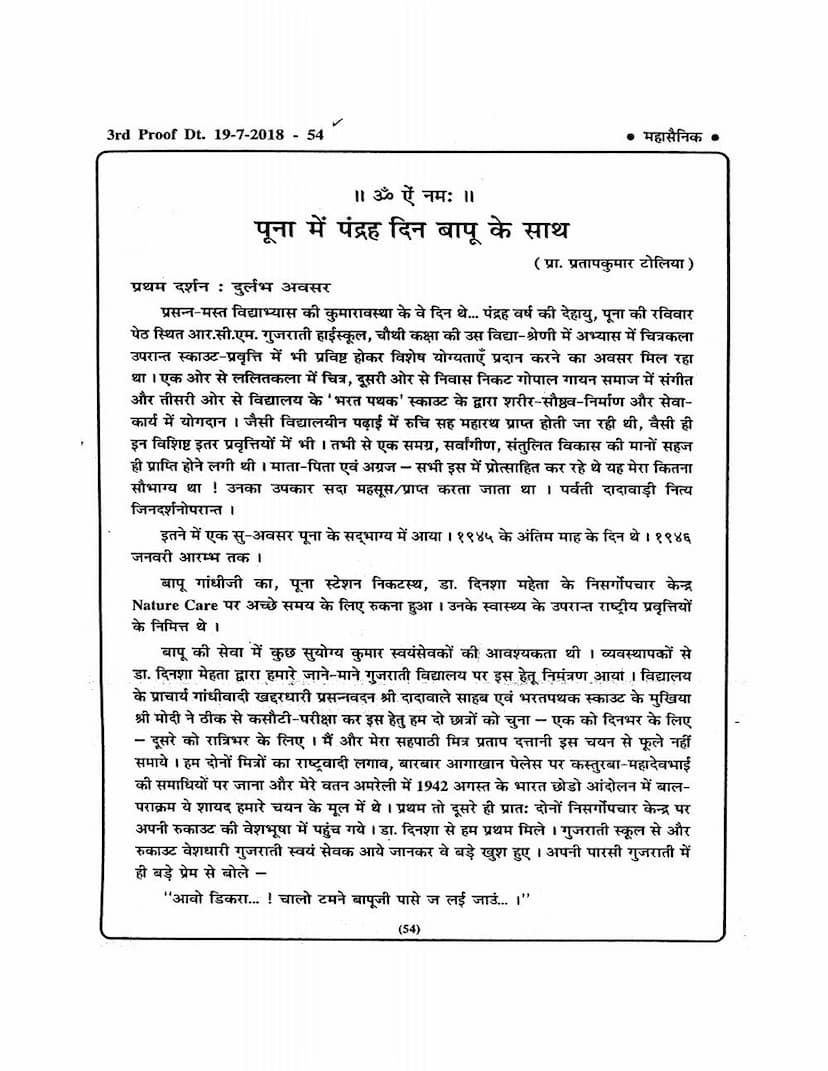Puna Me15 Din Bapu Ke Sath
Added to library: September 2, 2025

Summary
Here is a comprehensive summary of the Jain text "Puna Me15 Din Bapu Ke Sath" by Pratap J Tolia, based on the provided pages:
The book "Puna Me15 Din Bapu Ke Sath" (Fifteen Days with Bapu in Pune) by Pratap J Tolia recounts the author's profound personal experiences as a young volunteer serving Mahatma Gandhi in Pune. The narrative begins with the author, a fifteen-year-old student, describing his well-rounded education and extracurricular activities in school, including drawing, music, and scouting. He emphasizes the encouragement he received from his parents and elder brother, which fostered his holistic development.
The central event of the memoir is the author's selection, along with a friend, to serve as a volunteer for Mahatma Gandhi, who was staying at Dr. Dinsha Mehta's Nature Cure center in Pune in late 1945 and early 1946. The author highlights their eagerness to serve and attributes their selection to their nationalist sentiments and past participation in the Quit India Movement.
First Impressions and Service: The author vividly describes his first meeting with Gandhiji. He recalls Gandhi's simple demeanor, sitting on a coarse woolen mat, writing. Dr. Mehta introduces the young volunteers, and Gandhi warmly welcomes them. A significant moment is Gandhi's gentle questioning about their scout uniforms not being made of Khadi. He encourages them to consider making Khadi uniforms, explaining its significance, and suggests they understand the reason for Khadi from Dr. Mehta.
The author and his friend are assigned duties, including assisting with the evening prayer and collecting funds for the Harijan Fund. They experience immense joy in this service. The author shares the excitement of sharing his first encounter with Bapu with his family.
Daily Routine and Gandhi's Qualities: The narrative details the author's dedication, rising early to be at the Nature Cure center. He observes Gandhi's disciplined routine, including applying mud packs for health, welcoming visitors, and engaging in various activities. The author notes the constant stream of leaders like Sardar Patel, Jawaharlal Nehru, and Maulana Azad visiting Bapu, giving him the privilege of witnessing these interactions.
A particularly memorable incident involves the author and his friend playfully singing a modified devotional song. Gandhi's amused reaction and inquiry about their musical knowledge deeply impress the author. Gandhi's appreciation for their singing of a devotional song written by Raychandbhai reveals a shared spiritual connection.
Gandhi's Humour and Wisdom: The author notes Gandhi's ability to intersperse his serious national responsibilities with humor. He recalls a lighthearted exchange where Gandhi jokingly refers to him as "Maharana Pratap" and questions whom he would fight against. Gandhi's affirmation of fighting against the British and the slavery of the nation, but "ahimsa-purvak" (non-violently), leaves a lasting impression.
Observation of Gandhi's Discipline and Spirituality: The author is particularly struck by Gandhi's rigorous discipline, noting his ability to sleep at 2 AM and wake up at 4 AM without any sign of fatigue or illness. He describes Gandhi's consistent morning routine, including prayer, spinning on the charkha, and applying mud packs, all performed with remarkable regularity and equanimity. The author interprets this as a mastery of "yogic sleep" and reflects on the influence of his spiritual guide, Raychandbhai, in achieving such control.
Lesson on Poverty and Self-Sufficiency: During a Harijan Fund collection, Gandhi engages with two school girls, Ranjan and Pushpa. When Pushpa mentions giving a paisa daily to a beggar, Gandhi probes deeper, asking if this truly eradicates poverty. He then emphasizes the importance of adopting Swadeshi and learning to spin, not just for oneself but also to teach the impoverished, thus fostering self-reliance. This encounter profoundly impacts the author, showcasing the practical wisdom of Gandhi in addressing poverty.
Visits from Teachers and Family: The author recounts visits from his school teachers and family members, who come to see Bapu and the volunteers. These visits highlight the respect and admiration Gandhi commanded and the pride the author felt in serving him. He also reflects on whether Gandhi, having lost close companions like Kasturba and Mahadevbhai, felt their absence, observing Gandhi's consistent composure and dedication to his work, suggesting he internalized his grief.
Broader National Context and Gandhi's Inner State: The author situates his experience within the turbulent period of India's freedom struggle. He acknowledges the complex political landscape, including the rise of the Muslim League and the decisions made by Mountbatten, drawing parallels with the writings of Pyarelal and Narayan Desai (son of Mahadevbhai Desai). He speculates on Gandhi's inner turmoil during this critical phase, contrasting it with his outward strength and leadership.
Gandhi's Philosophy of Nature Cure and Spirituality: The text elaborates on Gandhi's deep commitment to Nature Cure and his spiritual practices, particularly his reliance on "Ramnam" (chanting the name of Rama) as taught by Raychandbhai. Gandhi's establishment of Nature Cure centers for the poor and his advocacy for a natural lifestyle are highlighted. The author draws a connection between Gandhi's adherence to nature and his spiritual quest, influenced by Raychandbhai's teachings on self-realization and detachment from worldly afflictions.
Personal Transformation and Legacy: The author's fifteen-day service with Gandhi serves as a pivotal moment in his life, instilling in him a deep appreciation for Nature Cure and spirituality. The gift of Gandhi's autobiography and later, of Raychandbhai's "Mokshamala" by his father, further shape his spiritual path. He describes how these influences led him to embrace a life of renunciation, spiritual practice, and service, inspired by both Gandhi and Raychandbhai.
The memoir concludes with the author reflecting on the profound impact of these experiences, leading to his involvement in various spiritual and social initiatives, often inspired by the teachings of Gandhi and Raychandbhai. He views his life as a continuation of their legacy, dedicating himself to spreading their message and ideals. The text emphasizes the interconnectedness of natural living, spiritual devotion, and social service as embodied by these two great souls.